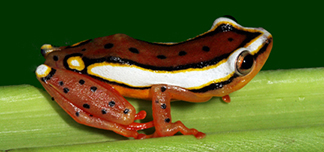| Publication Type: | Journal Article |
| Year of Publication: | 2005 |
| Authors: | E. Scott |
| Journal: | Cladistics |
| Volume: | 21 |
| Pagination: | 507-574 |
| Abstract: | During the last two decades, major taxonomic rearrangements were instituted in the anuran family Ranidae. Most of these changes were not based on phylogenetic analysis, and many are controversial. Addressing the phylogeny of Ranidae requires broader taxon sampling within the superfamily Ranoidea, the phylogenetic relationships and higher classification of which are also in a state of flux. No comprehensive attempt has yet been made to reconstruct ranid phylogeny using both morphological and molecular data. In the present contribution, data from 178 organismal characters were collated for 74 exemplar species representing the families Arthroleptidae, Hemisotidae, Hyperoliidae, Mantellidae Microhylidae, Petropedetidae, Rhacophoridae, Sooglossidae, and most subfamilies of Ranidae. These were combined with similar to 1 kb of DNA sequence from the mitochondrial 12S rDNA and 16S rDNA gene regions in a simultaneous parsimony analysis with direct optimization. Results support the classification of Hemisus with the brevicipitine microhylids, confirm that Arthroleptidae (and its two component subfamilies Astylosterninae and Arthroleptinae) are monophyletic, and advocate the recognition of Leptopelidae. Monophyly of Ranidae is compromised by recognition of Petropedetidae, Rhacophoridae and Mantellidae, which should be recognized as subfamilies of Ranidae at present. Furthermore, Petropedetidae was found to be grossly paraphyletic, comprising three clades which are all considered separate subfamilies of Ranidae, i.e., Petropedetinae, Phrynobatrachinae and Cacosterninae. Three well defined subfamilies of Ranidae were consistently retrieved as monophyletic in a sensitivity analysis, i.e., Tomopterninae, Ptychadeninae and Pyxicephalinae. However, Ptychadeninae and Pyxicephalinae were embedded in Raninae and Dicroglossinae, respectively. Ceratobatrachinae is removed from Dicroglossinae. Dicroglossinae is synonymized with Pyxicephalinae. A new subfamily Strongylopinae is proposed. Raninae should be conservatively treated as a "metataxon" (sensu Ford and Cannatella, 1993) until such time as it is fully revised. Tomopterninae is removed from synonymy with Cacosterninae. Morphological synapomorphies are reported for major monophyletic clades retrieved in the simultaneous analysis with equal weights. The present study found that many Old World clades appear to contain both African and Asian taxa, contrary to the findings of some recent biogeographical analyses. This study demonstrates the value of broad taxonomic sampling in ranid phylogeny, and highlights the immense contribution that can be made from detailed morphological data. (C) The Willi Hennig Society 2005. |
